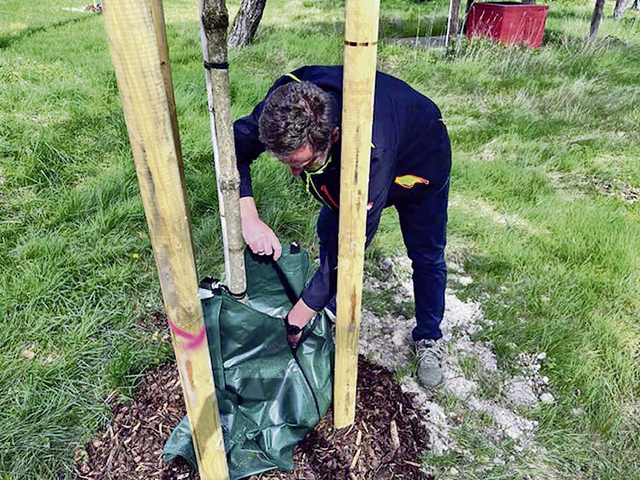
Nestled in the scenic terrain of Central Europe, the Germersheim Army Depot covers over 430 acres and plays a vital role as a logistics distribution and warehouse center for the U.S. Army Garrison Rheinland-Pfalz, based in Kaiserslautern. USAG-RP supports three primary tenant units on GAD, which functions as a crucial logistical hub receiving, storing, and distributing supplies all over Europe and Africa for entities such as the Army and Air Force Exchange Service, Defense Commissary Agency, and the Defense Logistics Agency. These efforts bolster missions across the European, Central Command, and Africa theaters of operation. Every day, more than 200 trucks traverse through its grounds. This lush and lively locale has been noted for its peaceful picnicking spots. However, in recent years, the tranquility of this area has been threatened by the harsh realities of climate change.
The combination of hot, dry summers and the permeable, sandy soils unique to the Germersheim area has led to the demise of a significant number of old trees, ranging from approximately 19 to 70 years old. These towering sentinels, once guardians of shade and shelter, have all but succumbed to the onslaught of environmental stressors.

Johannes Haid, GAD safety engineer and building biologist for the Department of Public Works and Environmental Management stated, “We are all affected by climate change. Even here on the installation. It was frightening to see that nearly 20 of the old and large pine trees on the post have died in the last two to three years due to the hot, dry summers.”
Recognizing the dangers posed by the dying trees, garrison authorities took swift action to ensure the safety of military personnel and guests by marking hazardous areas and cordoning them off during outdoor events such as the DeCA summer gathering. However, just like all things in life and nature, amidst the challenges lies opportunities for renewal and resilience. The objective is clear: replace the dying trees while preserving the special landscape character and central value of the area. This endeavor is not only a restoration effort but a proactive response to the escalating impacts of climate change on our natural environment.
In spring 2024, the DPW-ENV embarked on a groundbreaking initiative as part of the Environmental FY23 Natural Resources Management contract for USAG-RP. The focus was planting trees on Germersheim’s designated picnic area. But this was not a mere replication of the past. Instead, it was a thoughtful selection of tree species that could better withstand the evolving climate conditions. “We want to replace them with climate-resistant tree species and thus preserve the special character of the picnic area that our tenants can use. Tree planting is an effective measure to protect the climate and nature,” stated Haid.
A diverse array of trees was carefully chosen, blending Central European stalwarts with sub-Mediterranean species, each selected for its resilience and adaptability. Among them were Traubeneiche (Irish Oak), Flaumeiche (Pubescent Oak), Waldkiefer (European Red Pine), Schwarzkiefer (Black Pine), Esskastanie (Sweet Chestnut), and Walnuss (Walnut Tree).
The task did not end with planting; it extended to ensuring the survival and thriving of these new inhabitants. Adequate planting substrate, topsoil, watering bags, and sturdy stabilizations were put in place, laying the groundwork for their success. The outlook is one of cautious optimism.
The successful planting of trees will be evaluated in the following year, during the second vegetation period in fall 2025. This evaluation will not only gauge the survival rate of the new trees but also their ability to thrive in the face of the ever-changing climate conditions.
As Germersheim’s picnic area undergoes this transformative journey, it serves as a beacon of hope and resilience in the fight against climate change. Through thoughtful planning, proactive measures, and community engagement, we can work together to safeguard our precious natural spaces for generations to come. In sustaining the environment, the Army secures the mission by ensuring environmental infrastructure is managed in harmony and bin balance with readiness and modernization.
USAG RP manages 29,000 acres, with 23,608 maneuver acres.
The Army provides a home to more than 250 threatened and endangered species on 120 Army sites. There are approx. 650 legally protected Threatened and Endangered Species at USAG RP (more than 100 plant species and over 500 animal species).
USAG RP manages approx. 5,700 ha legally protected natural conservation/preservation areas, including state level protected biotopes (136 ha) up to European wide protected Natura 2000 Areas (5,470 ha).
USAG RP has 74 archaeological sites, consisting of graves and roads dating back to Celtic and Roman times as well as historical protected buildings and building ensembles.
The USAG RP still manages 23 active soil and groundwater cleanup projects


